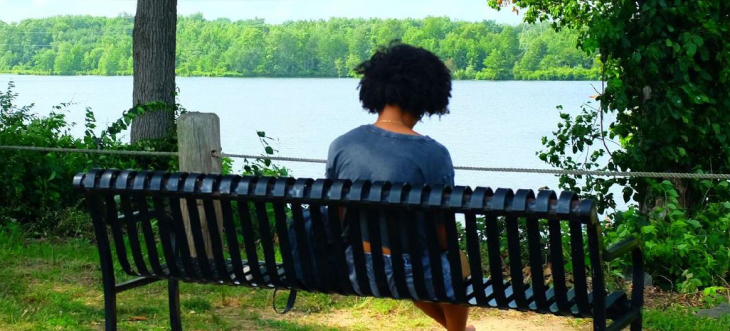The State We're In
An urgent call to preserve half of New Jersey’s land
By Jay Watson, Co-Executive Director
New Jersey is not only the nation’s most densely populated state, it’s also predicted to be the first to reach full build-out – the point where all land has been either developed or preserved. If current trends continue, full build-out could occur by the middle of this century.
Why is this important? Because New Jersey is reaching a tipping point, with our future quality of life hanging in the balance.
Right now, approximately a third of the state is developed; another third is permanently preserved as parks, open space and farmland; and a third is up for grabs.
Let’s talk about that final third. What happens on those acres will determine how healthy and sustainable a state we leave for our children and grandchildren – the generations that will be increasingly affected by climate change.
This week, New Jersey Conservation Foundation and its partners launched Nature for All: A 2050 Vision for New Jersey. Two years in the making, the report calls for ultimately permanently preserving half of the state’s land – including at least 500,000 acres by 2050 – and increasing high-quality green investments in our urban communities.
It’s a bold and ambitious goal, but one critical to the Garden State’s future livability.
New Jersey has about 1.4 million acres remaining that are neither developed nor preserved. These acres are not just sitting around doing nothing! They’re quietly providing priceless “ecosystem services”: preventing flooding by absorbing rainwater from storms, holding soils in place, filtering impurities from the air and water, sequestering carbon to fight climate change, providing habitat for a diversity of wildlife, and improving our food security.
If all those acres were to be developed, the massive loss of ecosystem services would be felt deeply throughout this state we’re in. Even with the best (and most expensive) engineering and technology, their benefits would be impossible to replace.
The idea of preserving half of our land is not new. In his 2016 book, Half Earth: Our Planet’s Fight for Life, the late Harvard biologist E.O. Wilson called for preserving 50 percent of the Earth’s land and waters to ensure the survival of humanity. He argued that humans need a high level of biodiversity on land and sea to survive, and that protecting 50 percent of the world’s lands and oceans will save 85 percent of our plants and animals.
New Jersey has a big advantage in that we’re already a national leader in preserving land. There’s been a lot of talk throughout the United States about preserving 30 percent of our land by 2030. The Garden State has already surpassed that goal, putting us well ahead of the curve.
But now is not a time to rest on our laurels. Michele S. Byers, New Jersey Conservation Foundation’s former executive director and the author of the report, noted that the pace of land conservation in New Jersey has slowed in recent years.
At our peak in the early 2000s, New Jersey was permanently preserving 18,000 to 20,000 acres per year. During the past decade, we’ve dropped to about 12,000 acres a year.
To reach the ultimate goal of preserving 50 percent of our land mass, we must preserve an additional 800,000 acres. Admittedly, it won’t be easy or cheap.
But it would be even more costly not to take action. In addition to providing ecosystem services worth billions of dollars, preserved parks and green spaces provide incredible physical and mental health benefits to residents.
As Michele puts it, “Nature is not a luxury – it’s a necessity for life in New Jersey and on the planet as a whole. Everyone has to have nature in their own neighborhood.”
The Nature for All report calls for New Jersey to establish a “Green and Healthy Cities” initiative to improve water and air quality, reduce flooding risks, remediate contaminated sites, improve access to healthy local foods, provide clean and safe parks and waterways, plant trees, enhance existing urban forests, and expand urban agriculture and community gardens.
New Jersey faces many challenges in the years ahead, including protecting residents from the impacts of climate change, securing a safe and adequate water supply, addressing the loss of native plants and animals, safeguarding our food supply, and providing environmental justice for underserved communities.
But we can secure a bright future if we have the will.
“We’re from New Jersey. We have grit and we never shy away from a challenge,” said Eric Olsen, the Director of Conservation Programs for The Nature Conservancy and a major contributor to the report.
Land is scarce, precious, and non-renewable. But its benefits continue forever once preserved, protected from development, and carefully stewarded. For over 60 years, New Jersey residents have been staunch supporters of land preservation, passing every open space ballot question put before them. For the sake of New Jersey’s future generations, we must carry on this legacy.
To read the Nature for All report, go to https://www.njconservation.org/nature-for-all/. It was compiled with the help of some of the best minds in New Jersey – over 70 individuals and organizations, all listed in the report.
And for more information about preserving New Jersey’s land and natural resources, visit the New Jersey Conservation Foundation website at www.njconservation.org or contact me at info@njconservation.org.
About the Authors
Alison Mitchell
Co-Executive Director
John S. Watson, Jr.
Co-Executive Director
Tom Gilbert
Co-Executive Director, 2022-2023
Michele S. Byers
Executive Director, 1999-2021
View their full bios here.
Filter
Get The Latest News
From The Garden State
In the
News

